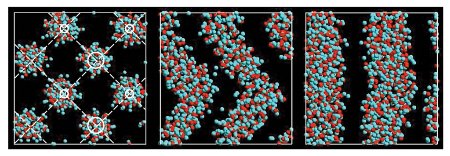Dec. 18, 2009 Research Highlight Physics / Astronomy
Supernovae host a pasta dinner
The nuclei in the core of a collapsing supernova can form a range of unusual ‘pasta-like’ structures
 Figure 1: Simulations showing the transformation of spherical nuclei in a lattice (left) into zigzag shapes (center) and columns (right) when pressure is applied to the lattice. Such shape transitions may occur at the core of a supernova (protons, red; neutrons, blue). Reproduced, with permission, from Ref. 1 © (2009) by the American Physical Society
Figure 1: Simulations showing the transformation of spherical nuclei in a lattice (left) into zigzag shapes (center) and columns (right) when pressure is applied to the lattice. Such shape transitions may occur at the core of a supernova (protons, red; neutrons, blue). Reproduced, with permission, from Ref. 1 © (2009) by the American Physical Society
The dense matter at the interior of a collapsing star—or ‘supernova’—is unlike anything that can be replicated in a laboratory. Scientists therefore rely on simulations to predict the behavior of electrons, protons and neutrons in these stellar explosions.
Now, scientists at the RIKEN Nishina Center for Accelerator-Based Science in Wako, and several other institutions in Japan, have shown that the proton- and neutron-containing nuclei at the core of supernovae are likely to form a range of unusual shapes1. These structures, called ‘pasta phases’ because of their similarity to strands of spaghetti or flat slabs of lasagna, are different from the mostly spherical nuclei found at the center of atoms and are likely to affect the dynamics of supernova explosions.
Predictions that pasta phases form in supernovae are not new, but the earlier work was based on models that assumed the nuclear structures did not change through time. In an actual collapsing supernova, however, the core density is not static. Gentaro Watanabe, a lead author of the paper, and his colleagues therefore performed new simulations to look for pasta phases in a supernova. They used a method called ‘quantum molecular dynamics’ that takes into account the realistic time evolution of nuclei at the supernova core.
The researchers started by assuming that large spherical nuclei are distributed periodically in a lattice such that the total density is about 15% that of normal nuclear matter. They then simulated what happens to the nuclei as the lattice is compressed. They found that the spherical nuclei merge into zigzag shapes and ultimately into columns (Fig.1), confirming that pasta phases should exist in supernovae.
Scientists had long believed that what caused spherical nuclei to deform into longer rod-like shapes was a so-called fission instability that forced the nuclei to break apart. “The actual formation process of the pasta phases is very different from this generally accepted scenario,” says Watanabe. He and his team have shown that the attraction between neighboring nuclei is what drives the shape changes.
In addition to advancing the understanding of nuclear structures, the results will also be important for astrophysics. “Supernova explosions are very complicated phenomena, and we do not know exactly how pasta phases change the dynamics of supernova explosions,” explains Watanabe. “In the future, we would like to simulate the collapse of the supernova core, taking into account the effect of the pasta phases.”
References
- 1. Watanabe, G., Sonoda, H., Maruyama, T., Sato, K., Yasuoka, K. & Ebisuzaki, T. Formation of nuclear “pasta” in supernovae. Physical Review Letters 103, 121101 (2009). doi: 10.1103/PhysRevLett.103.121101
